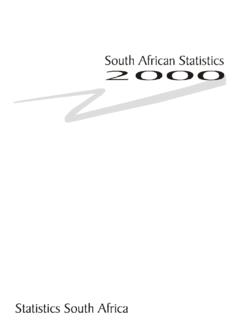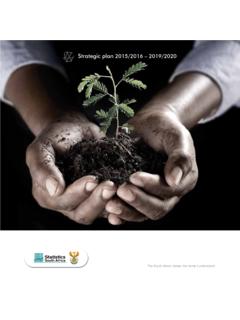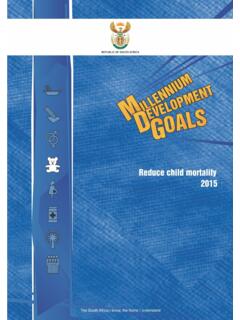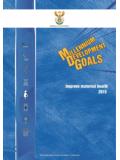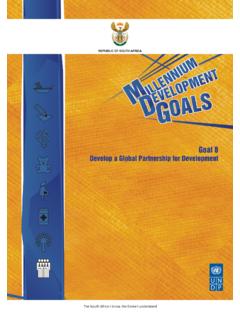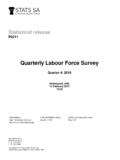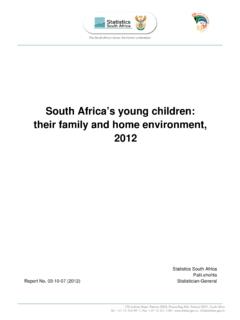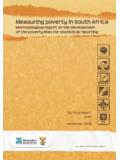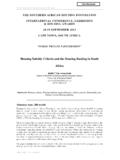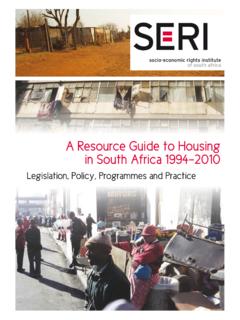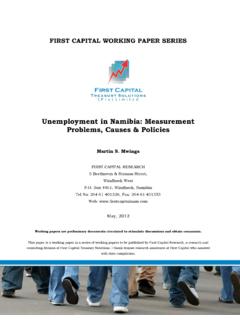Transcription of Poverty Trends in South Africa - Statistics South …
1 Poverty Trends in South Africa An examination of absolute Poverty between 2006 and 2011. The South Africa I know, the home I understand De Bruyn Park Building, 170 Thabo Sehume Street, Pretoria, 0002. Private Bag X44, Pretoria, 0001, South Africa User information service: +27(12) 310 8600, Fax: +27(12) 310 8500. Main switchboard: +27(12) 310 8911, Fax: +27(12) 321 7381. Website: , Email: Poverty Trends in South Africa An examination of absolute Poverty between 2006 and 2011. Statistics South Africa , 2014. Pali Lehohla, Statistician-General Report No. 03-10-06. Poverty Trends in South Africa : An examination of absolute Poverty between 2006 and 2011 / Statistics South Africa Published by Statistics South Africa , Private Bag X44, Pretoria 0001.
2 Statistics South Africa , 2014. Users may apply or process this data, provided Statistics South Africa (Stats SA) is acknowledged as the original source of the data; that it is specified that the application and/or analysis is the result of the user's independent processing of the data; and that neither the basic data nor any reprocessed version or application thereof may be sold or offered for sale in any form whatsoever without prior permission from Stats SA. Stats SA Library Cataloguing-in-Publication (CIP) Data Poverty Trends in South Africa : An examination of absolute Poverty between 2006 and 2011 / Statistics South Africa .
3 Pretoria: Statistics South Africa , 2014. Report no.: 03-10-06. 80pp ISBN 978-0-621-41873-6. A complete set of Stats SA publications is available at Stats SA Library and the following libraries: National Library of South Africa , Pretoria Division National Library of South Africa , Cape Town Division Library of Parliament, Cape Town Bloemfontein Public Library Natal Society Library, Pietermaritzburg Johannesburg Public Library Eastern Cape Library Services, King William's Town Central Regional Library, Polokwane Central Reference Library, Nelspruit Central Reference Collection, Kimberley Central Reference Library, Mmabatho This report is available on the Stats SA website.
4 For technical enquiries, please contact: Werner Ruch Tel: (012) 337 6318. Email: Ross Jennings Tel: (012) 337 6342. Email: Copies are obtainable from: Printing and Distribution, Statistics South Africa Tel: (012) 310 8093. (012) 310 8619. Email: Contents Preface 1. Cautionary notes 3. Introduction 5. Background to the surveys 6. Background to the national Poverty lines 7. The 'social wage' 8. Outline of this report 9. Key findings 11. Poverty and inequality from 2006 to 2011 12. Progress towards the NDP's Poverty target 14. Overview of the economic and social environments 14. Summary 22. Findings Individual Poverty 25.
5 Poverty at individual level 26. Poverty and population group 27. Poverty and age 28. Poverty and education 30. Poverty at provincial level 31. Poverty and settlement type 33. Quantifying the Poverty gap 34. Inequality at individual level 35. Summary 36. Household Poverty 39. Poverty at household level 40. Household Poverty by population group 41. Household Poverty and education level of household head 42. Household Poverty at provincial level 44. Household Poverty and settlement type 46. Summary 47. Household expenditure 49. Average household expenditure 50. Household expenditure for poor and non-poor households 52.
6 Food expenditure for poor and non-poor households 55. Household expenditure and sex of household head 56. Household expenditure in rural and urban areas 58. Expenditure and quintiles 60. Summary 61. Explanatory notes 63. Poverty lines 64. The instruments of data collection 65. How the surveys were conducted 66. Data collection 67. Time span 67. Sample coverage 67. Response details 68. Comparison to previous Poverty reports 68. Concepts and definitions 71. List of tables Table 1: Comparison of the IES 2005/2006, LCS 2008/2009 and IES 2010/2011 7. Table 2: Inflation-adjusted Poverty lines (per capita per month in Rands) 8.
7 Table 3: Poverty headcounts in 2006, 2009 and 2011 12. Table 4: Poverty gaps in 2006, 2009 and 2011 13. Table 5: Inequality, 2006 to 2011 14. Table 6: Progress towards NDP's Poverty target 14. Table 7: Poverty measures by sex 27. Table 8: Poverty measures by population group 28. Table 9: Poverty measures by age 29. Table 10: Poverty measures by education level attained for individuals aged 18. and older 31. Table 11: Poverty measures by province 31. Table 12: Poverty measures by settlement type 34. Table 13: Quantifying the Poverty gap in 2011 by province 35. Table 14: Poverty measures of households by sex of household head 40.
8 Table 15: Poverty measures of households by population group of household head 42. Table 16: Poverty measures of households by education level of household head 43. Table 17: Poverty measures of households by province 45. Table 18: Poverty measures of households by settlement type 46. Table 19: Average annual household consumption expenditure in 2011 by population group of household head and change from 2006 51. Table 20: Average expenditure on food items by Poverty status 54. Table 21: Data collection activities by week 66. Table 22: Data collection activities by week for the IES 2010/2011 67.
9 Table 23: Response rates for the IES 2005/2006, LCS 2008/2009 and IES 2010/2011 68. List of figures Figure 1: Percentage of individuals going hungry between 2002 and 2011 12. Figure 2: Gross domestic product from 2004 to 2012 15. Figure 3: Number of employed persons and the unemployment rate from 2004. to 2012 16. Figure 4: Prime interest rates from 2004 to 2012 17. Figure 5: Percentage change from quarter to quarter on real final consumption expenditure by households 18. Figure 6: Inflation from 2004 to 2012 19. Figure 7: Number of social grants disbursed between 2000 and 2012 20. Figure 8: Distribution of type of dwelling 21.
10 Figure 9: Poverty headcount by sex 26. Figure 10: Poverty headcount by population group 27. Figure 11: Poverty headcount by age 28. Figure 12: Poverty headcount by education level attained for individuals aged 18 and older 30. Figure 13: Poverty share by province in 2011 and change from 2006 32. Figure 14: Poverty headcount by settlement type 33. Figure 15: Quantifying the Poverty gap 34. Figure 16: Gini coefficient by population group 35. Figure 17: Poverty incidence of households by sex of household head 41. Figure 18: Poverty incidence of households by population group of household head 41.
